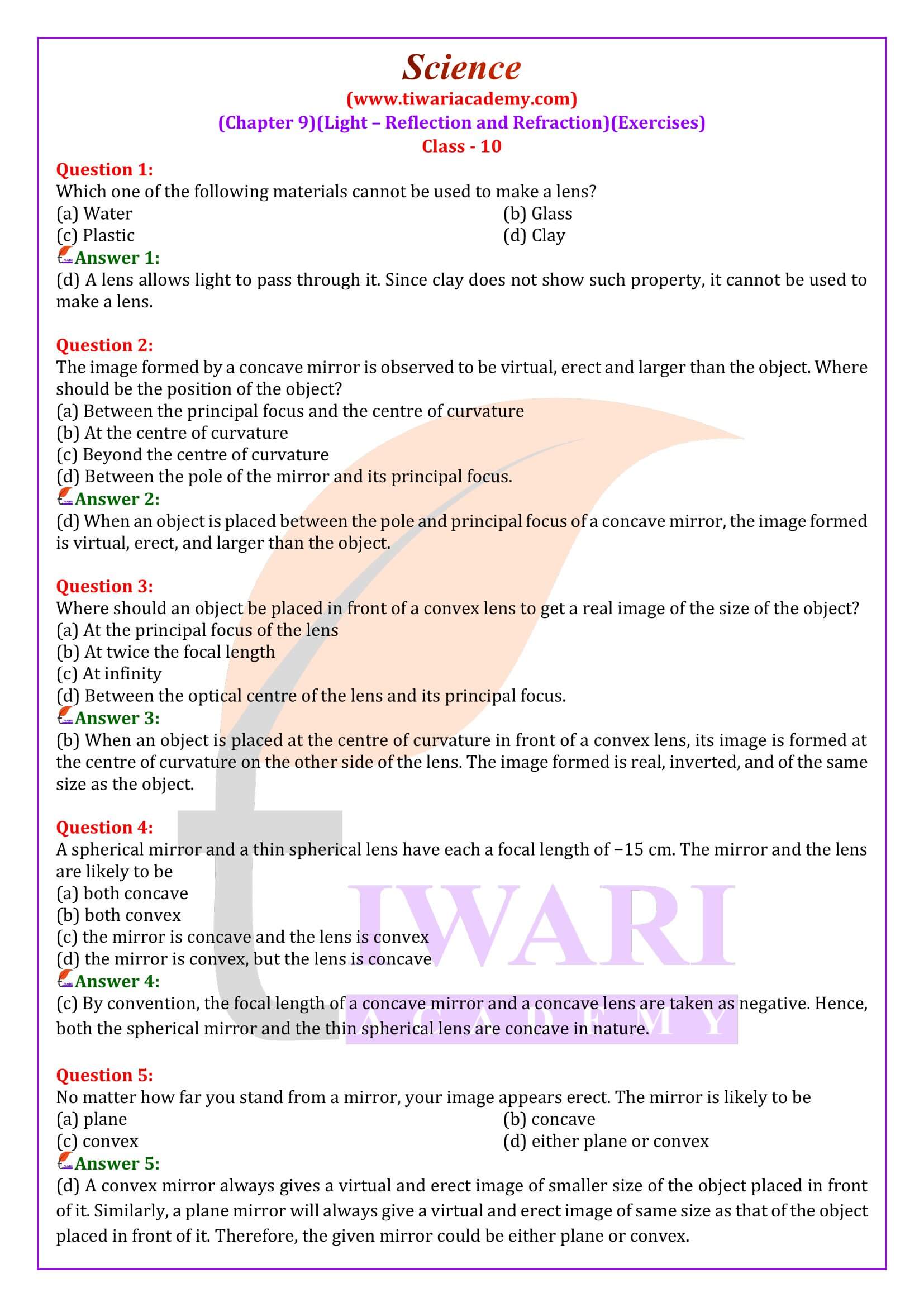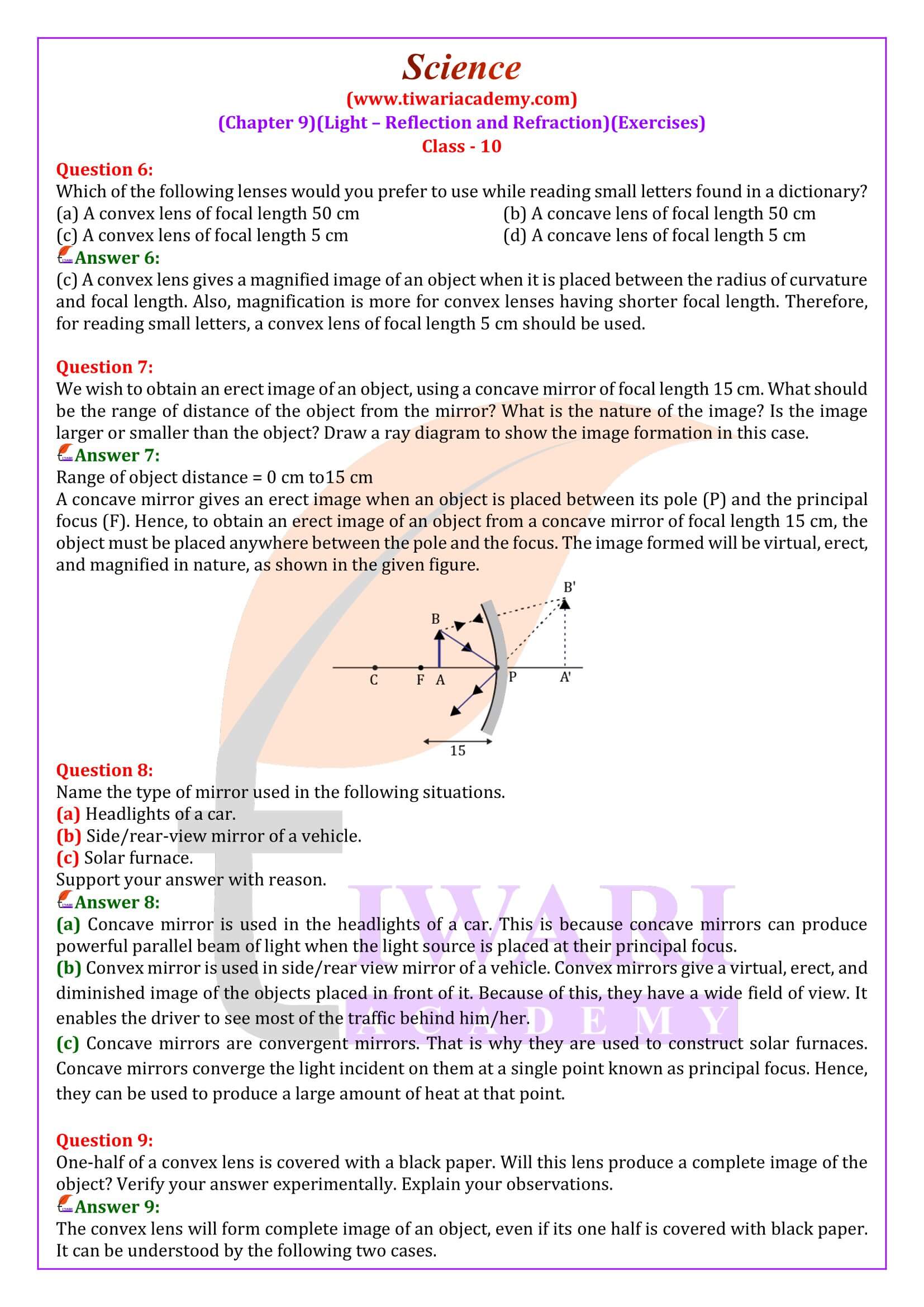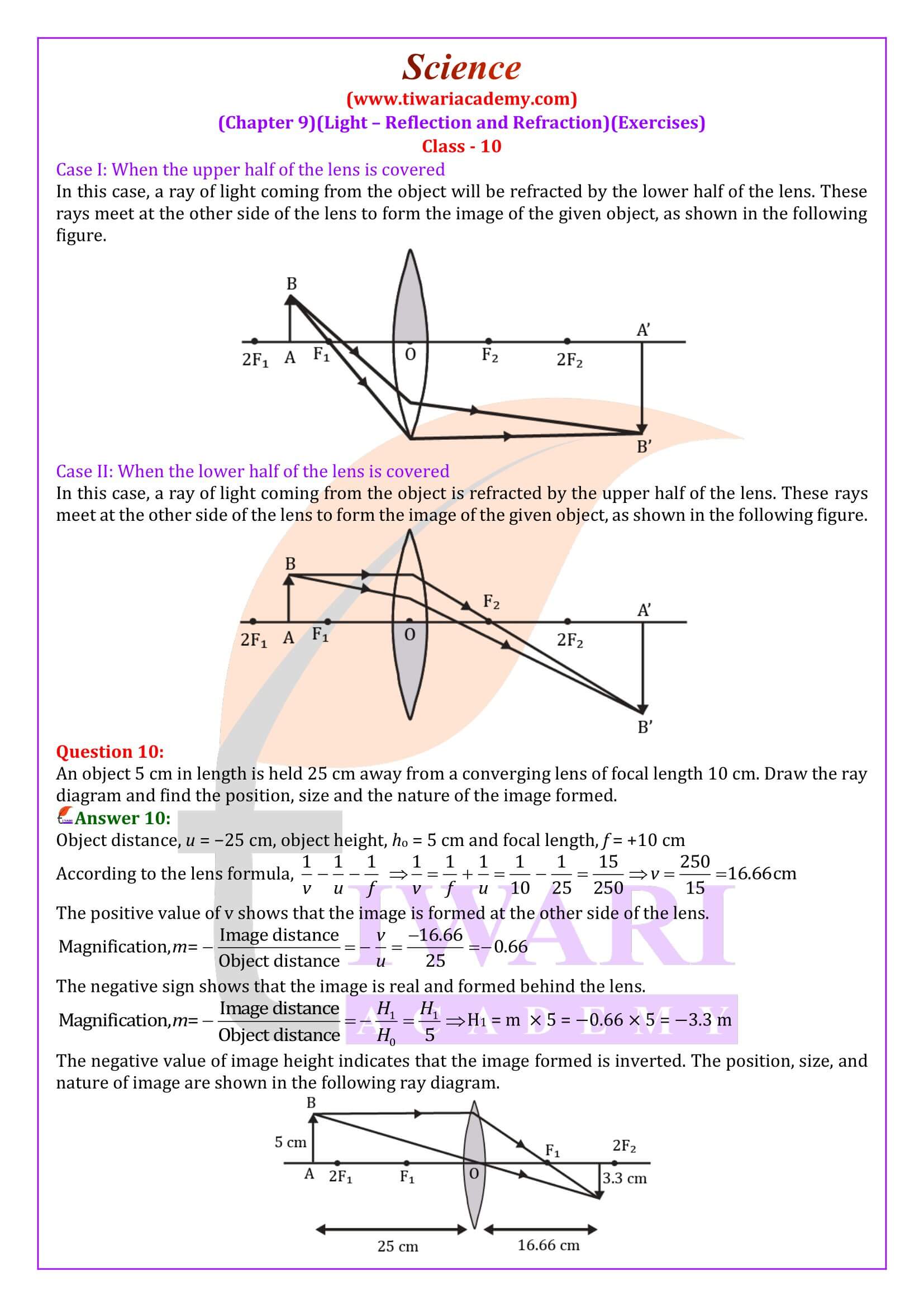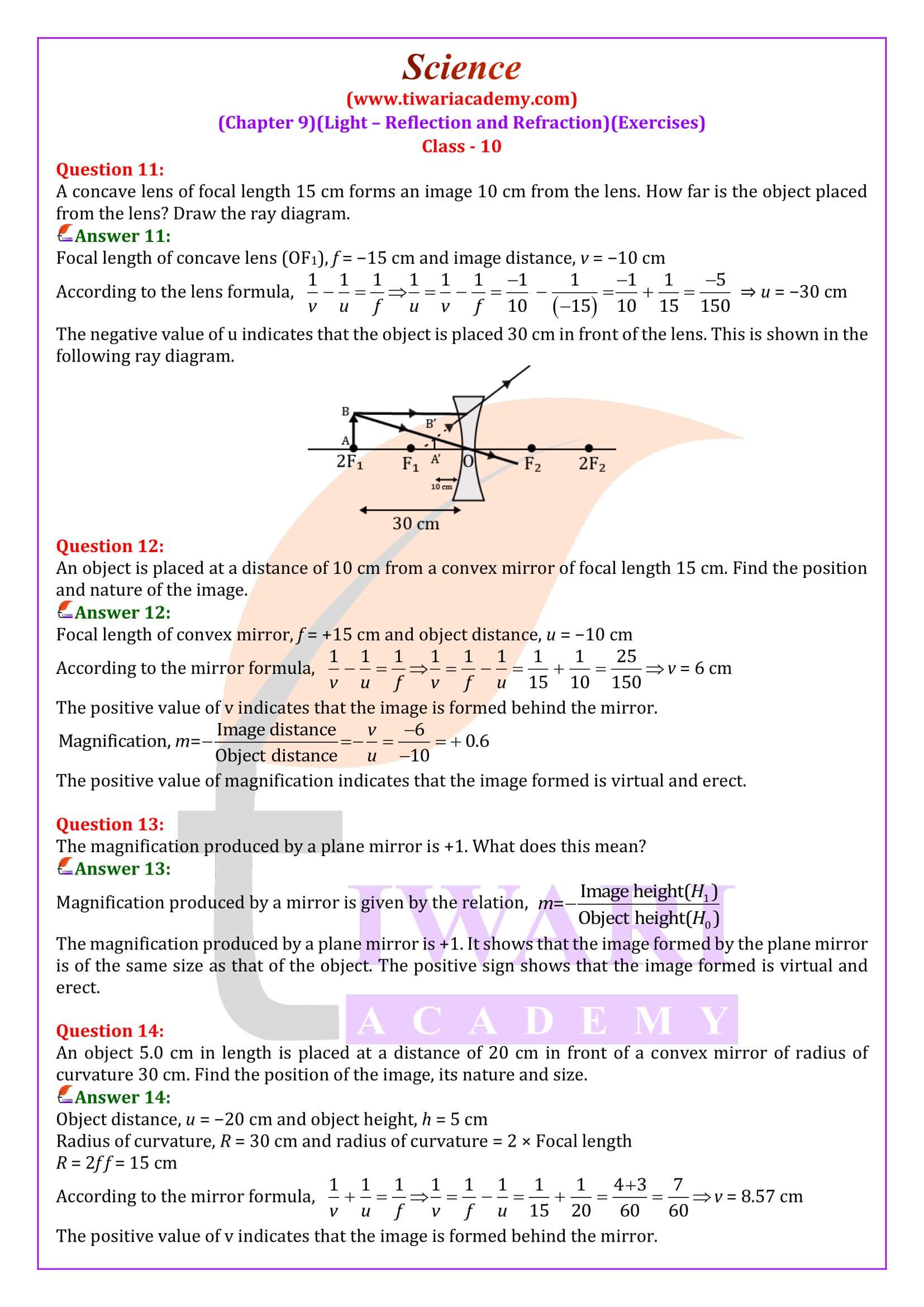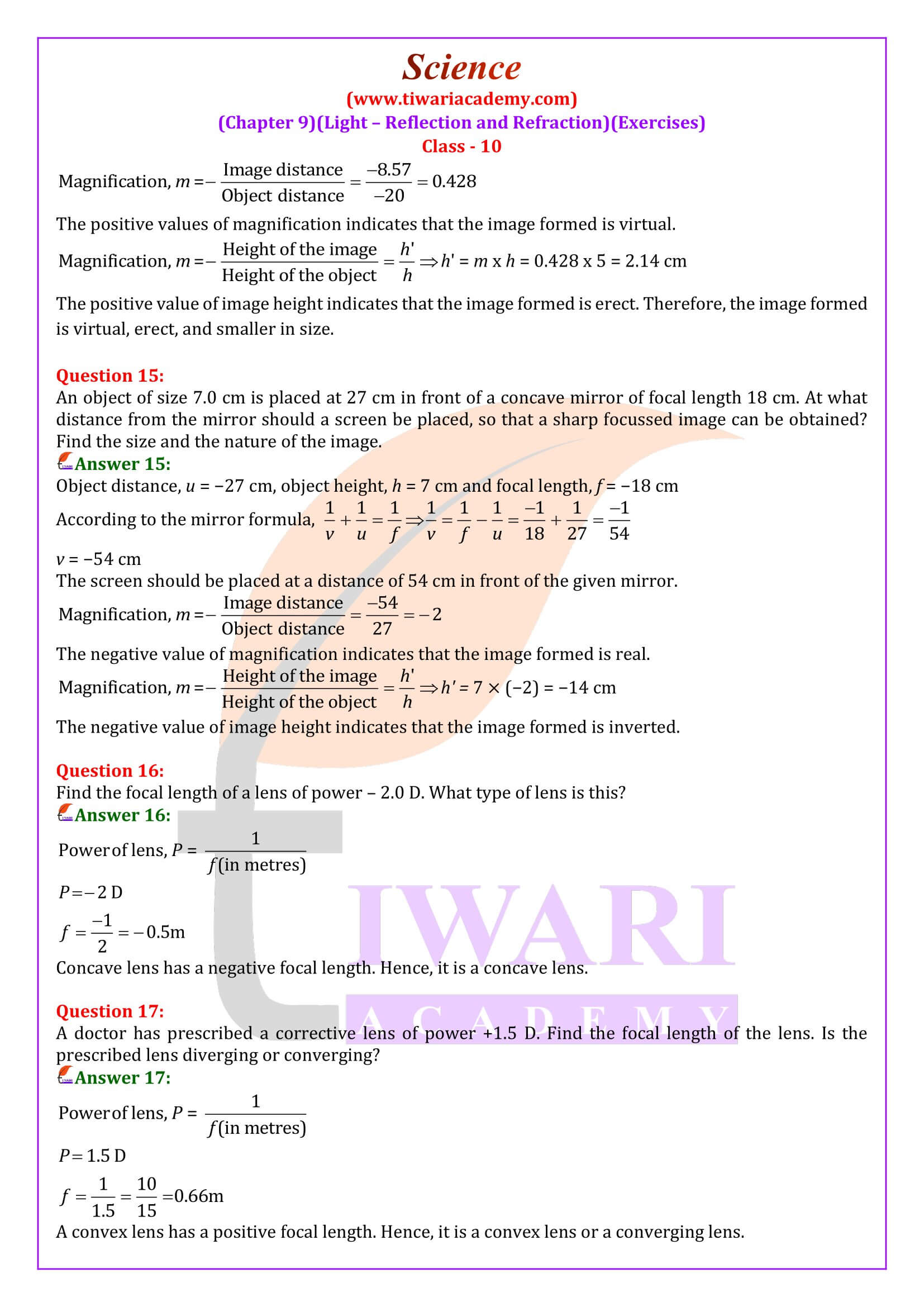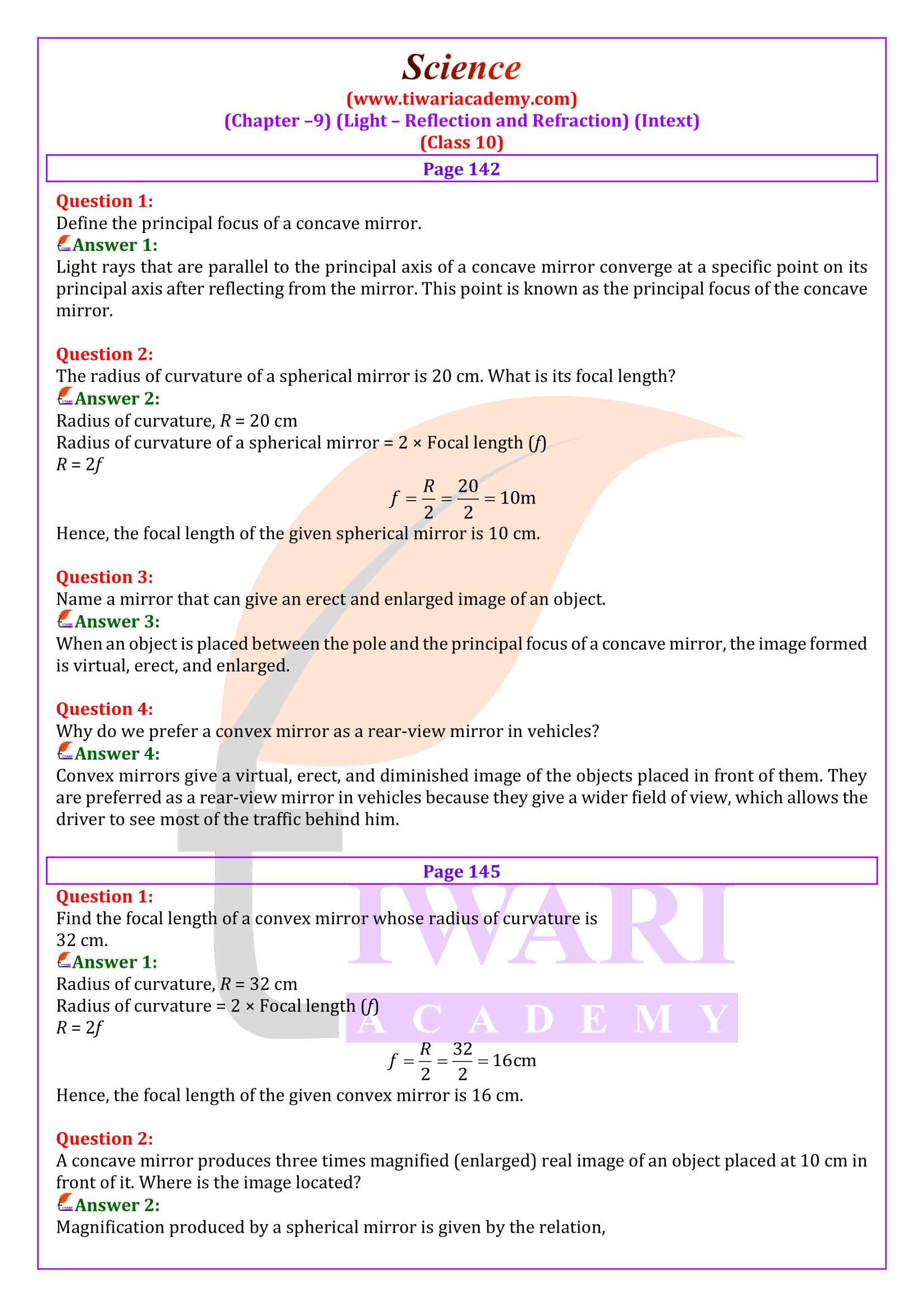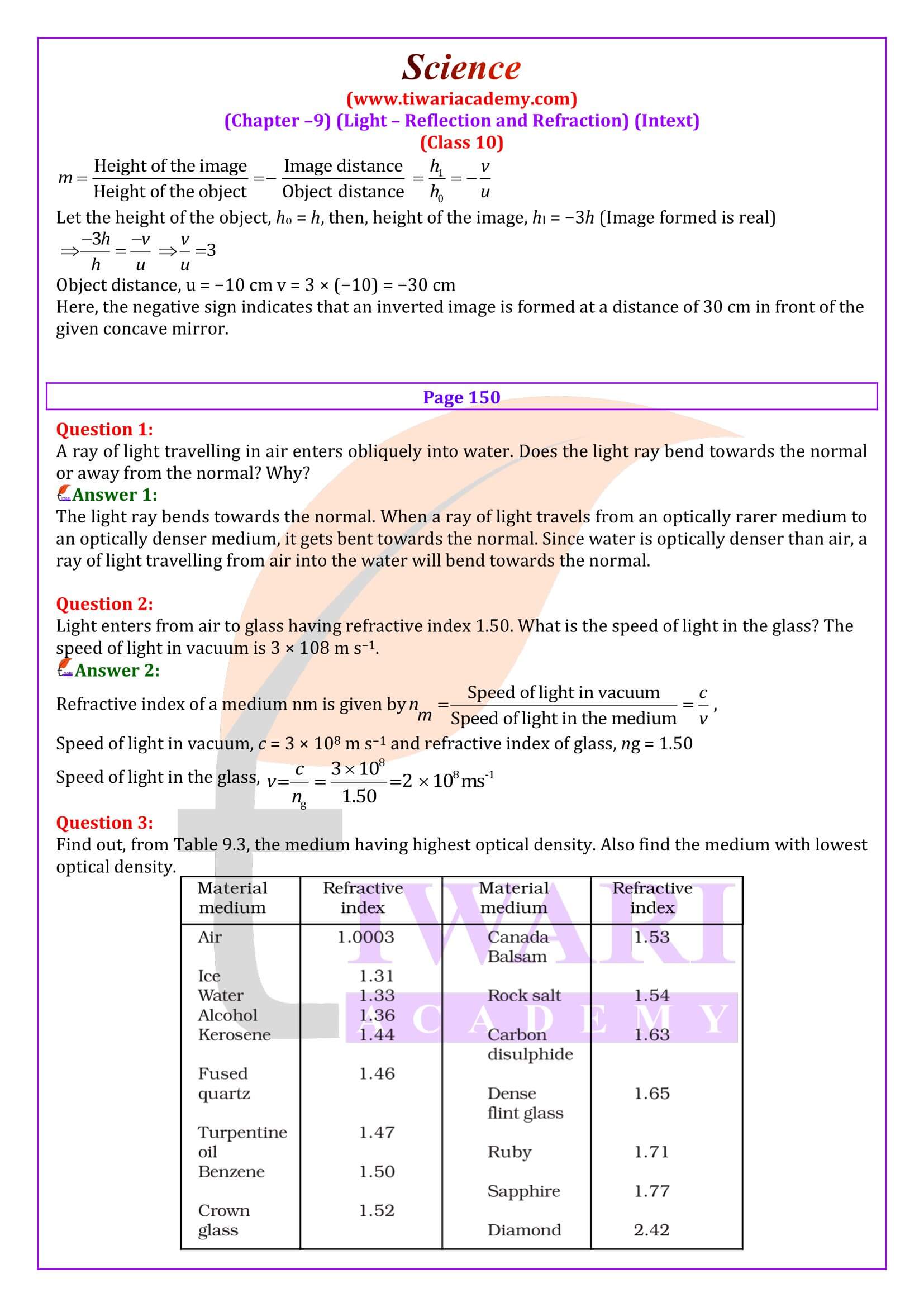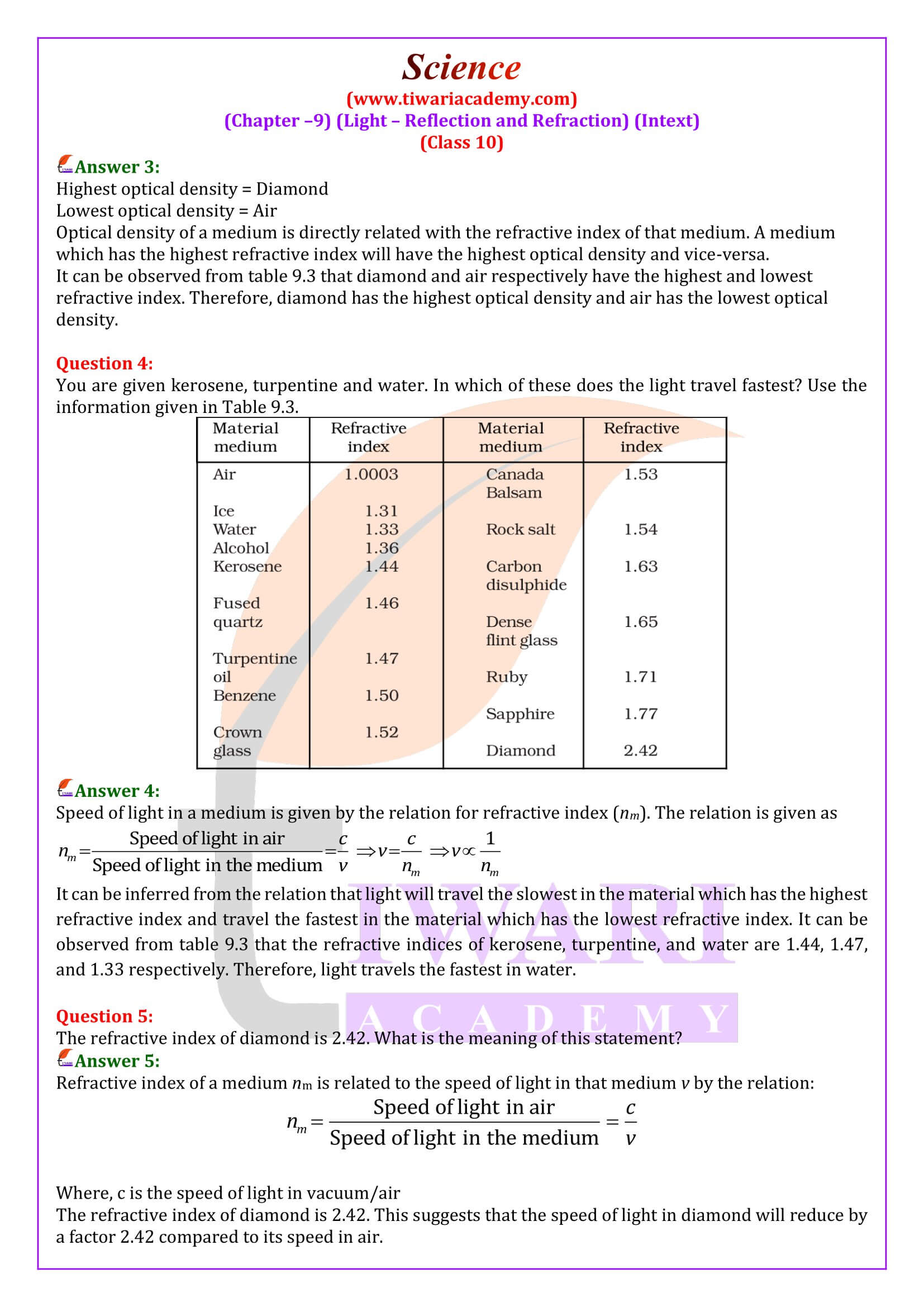NCERT Solutions for Class 10 Science Chapter 9 Light Reflection and Refraction in Hindi and English Medium for CBSE 2025-26. The question answers and explanation of chapter 9 class 10th science are revised according to syllabus and new textbooks issued for academic session 2025-26.
Revision of Class 10 Science for Board Exam
Class 10 Science Chapter 9 Solutions
Class 10 Science Chapter 9 Exercises Solutions
Class 10 Science Chapter 9 Intext Exercises
Class 10 Science Chapter 9 MCQ
Class 10 Science Chapter 9 in Hindi Medium
Class 10 Science Book Download in PDF
Class 10 Science Chapter 9 Board Questions
Class 10 Science Chapter 9 Extra Questions
| Class: 10 | Science |
| Chapter 9: | Light – Reflection and Refraction |
| Content: | Exercise and Intext Question Answers |
| Content Mode: | PDF and Videos Format |
| Session: | CBSE 2025-26 |
| Medium: | English and Hindi Medium |
Class 10 Science Chapter 9 Questions in Detail
- Define the principal focus of a concave mirror.
- The radius of curvature of a spherical mirror is 20 cm. What is its focal length?
- Name a mirror that can give an erect and enlarged image of an object.
- Why do we prefer a convex mirror as a rear-view mirror in vehicles?
- Find the focal length of a convex mirror whose radius of curvature is 32 cm.
- A concave mirror produces three times magnified (enlarged) real image of an object placed at 10 cm in front of it. Where is the image located?
- A ray of light travelling in air enters obliquely into water. Does the light ray bend towards the normal or away from the normal? Why?
- Light enters from air to glass having refractive index 1.50. What is the speed of light in the glass?
- Find out, from Table, the medium having highest optical density. Also find the medium with lowest optical density.
- You are given kerosene, turpentine and water. In which of these does the light travel fastest?
- The refractive index of diamond is 2.42. What is the meaning of this statement?
- Define 1 dioptre of power of a lens.
- A convex lens forms a real and inverted image of a needle at a distance of 50 cm from it. Where is the needle placed in front of the convex lens if the image is equal to the size of the object?
- Find the power of a concave lens of focal length 2 m.
- We wish to obtain an erect image of an object, using a concave mirror of focal length 15 cm. What should be the range of distance of the object from the mirror?
- Name the type of mirror used in the following situations. (a) Headlights of a car. (b) Side/rear-view mirror of a vehicle. (c) Solar furnace.
- One-half of a convex lens is covered with a black paper. Will this lens produce a complete image of the object?
- An object 5 cm in length is held 25 cm away from a converging lens of focal length 10 cm. What is the position, size and the nature of the image formed.
- A concave lens of focal length 15 cm forms an image 10 cm from the lens. How far is the object placed from the lens?
- An object is placed at a distance of 10 cm from a convex mirror of focal length 15 cm. Find the position and nature of the image.
- The magnification produced by a plane mirror is +1. What does this mean?
- An object 5.0 cm in length is placed at a distance of 20 cm in front of a convex mirror of radius of curvature 30 cm. Find the position of the image, its nature and size.
- An object of size 7.0 cm is placed at 27 cm in front of a concave mirror of focal length 18 cm. At what distance from the mirror should a screen be placed, so that a sharp focussed image can be obtained?
- Find the focal length of a lens of power – 2.0 D. What type of lens is this?
- A doctor has prescribed a corrective lens of power +1.5 D. Find the focal length of the lens. Is the prescribed lens diverging or converging?
Class 10 Science Chapter 9 Answers in English Medium
An Overview of Class 10 Science Chapter 9
Introduction to Light: The class 10 science chapter 9 begins by explaining the importance of light in making objects visible and discusses common optical phenomena like image formation by mirrors, twinkling of stars, and rainbows. It also touches upon the straight-line propagation of light and introduces the concepts of diffraction and the modern quantum theory of light.
Reflection of Light: The laws of reflection are revisited, emphasizing that the angle of incidence equals the angle of reflection and that the incident ray, the normal at the point of incidence, and the reflected ray all lie in the same plane. Class 10 science chapter 9 applies these laws to various types of reflecting surfaces, including spherical surfaces.
Spherical Mirrors: The class 10 science chapter 9 delves into the details of spherical mirrors, distinguishing between concave and convex mirrors. It explains the terminology related to spherical mirrors, such as the pole, centre of curvature, radius of curvature, principal axis, and focus.
Image Formation by Spherical Mirrors: The 10th science chapter 9 explores how images are formed by spherical mirrors, focusing on the nature, position, and size of images in relation to the object’s position. It includes practical activities to understand these concepts better.
Ray Diagrams and Image Representation: The 10th science chapter 9 provides guidance on constructing ray diagrams for spherical mirrors to locate images of objects. It explains the use of specific rays for this purpose and how the intersection of reflected rays determines the image’s position.
Tables and Illustrations: This chapter includes tables summarizing the nature, position, and size of images formed by concave mirrors for different object positions. It also contains figures illustrating the concepts discussed.
NCERT Class 10 Science Chapter 9, Light – Reflection and Refraction, explores various aspects of light, how it interacts with different surfaces, and how it behaves when it passes through different materials. Here are the main topics covered in this chapter. Reflection of light, and introduction to reflection. Formation of an image by a plane mirror. Characteristics of images formed by plane mirrors. Spherical mirrors, concave and convex mirrors. Focal point, principal focus, and focal length. Sign convention for mirrors. Mirror equation.
Mirror Formula and Magnification
Deriving the mirror formula, calculating magnification, the relationship between the object and image distance, and focal length. Refraction of light, introduction to refraction. Refraction of light through a glass slab. Laws of refraction, Snell’s law. Refraction of light through a rectangular glass slab. Dispersion of light and spectrum, dispersion of white light through a prism. Formation of a spectrum, colors of a spectrum. Recombination of a spectrum to form white light.
Atmospheric Refraction
Explanation of the apparent position of the sun during sunrise and sunset due to atmospheric refraction. The human eye, its structure. Accommodation, defects of vision, myopia (near-sightedness), and hypermetropia (far-sightedness). Correction of vision defects using lenses. Power of a lens, Introduction to lenses (convex and concave). Sign convention for lenses. Lens formula and magnification.
Refraction of Light through a Prism
Deviation and dispersion by a prism. Rainbow formation. Some natural phenomenon due to sunlight is the formation of a Rainbow. Atmospheric refraction causes the apparent bending of stars and other celestial bodies. These topics cover the basic principles of light, its reflection and refraction, the behavior of light in different media, the functioning of the human eye, and various optical phenomena. Understanding this chapter is essential for a strong foundation in optics and light-related concepts in physics.
NCERT Solutions for Class 10 Science Chapter 9
Download all answers in PDF file format or download Offline apps to use all the contents offline without internet. UP Board students are also using NCERT Textbook for their final exams. So, 10th Science chapter 9 question answers are useful for UP Board students also. Download here the UP Board Solutions for Class 10 Science Chapter 10 in Hindi Medium to view online or download free in PDF format.
Important questions and CBSE previous years board questions related to chapter 9 are given with answers. All NCERT Solutions as well as NCERT Offline Apps are based on latest NCERT Books 2025-26 following the latest CBSE Syllabus 2025-26. Class X Science chapter 9 all intext questions given on Page 168 or Page 171 or Page 176 or Page 184 or Exercises in English and Hindi Medium free.
Preparing for NCERT Class 10 Science Chapter 9, Light – Reflection and Refraction, in an effective manner requires a structured approach and a focus on understanding the concepts. Here’s a step-by-step guide to help you prepare for this chapter. Read the chapter thoroughly, and begin by reading the entire chapter carefully from your NCERT textbook. Pay attention to definitions, laws, and principles introduced in the chapter. Make notes, and create concise notes while reading the chapter. Summarize key points, formulas, and concepts. Highlight important terms and definitions.
Understand Laws of Reflection and Refraction
Ensure you understand the laws of reflection (angle of incidence equals angle of reflection) and the laws of refraction (Snell’s law). Practice drawing ray diagrams to visualize reflection and refraction. Experiment with Mirrors and Lenses: If possible, conduct simple experiments with mirrors, lenses, and prisms to observe reflection and refraction phenomena firsthand. This practical experience can deepen your understanding of the chapter. Work through the numerical problems related to mirrors and lenses. Pay attention to units and use the mirror and lens formula to solve problems.
Use Diagrams and Illustrations
Draw diagrams and illustrations for different scenarios involving mirrors, lenses, and prisms. Visual aids can help you understand complex concepts. Focus on the human eye and vision, Study the structure of the human eye and its various parts. Understand the concept of accommodation and how the eye focuses on objects at different distances. Learn about vision defects, and familiarize yourself with common vision defects such as myopia and hypermetropia. Learn how these defects can be corrected using appropriate lenses. Solve the NCERT Exemplar problems related to this chapter for additional practice. These problems often provide a deeper insight into the concepts.
10th Science Chapter 9 Answers in English & Hindi Medium
NCERT question answers for Class 10 Science Chapter 9 Light – Reflection and Refraction all the question answers of intext questions as well as chapter end exercises are given below updated for 2025-26. NCERT solutions for class 10 other subjects are also in PDF as well as online to use.
Practice Previous Year’s Questions
Solve previous years’ board exam questions related to this chapter. Look for online tutorials, videos, and interactive simulations related to reflection, refraction, and optical phenomena. These resources can provide additional clarity on complex topics. If you have any doubts or find concepts challenging, don’t hesitate to seek help from your teacher or classmates.
Questions for Practice
Class 10 Science Chapter 9 Extra Question Answer
List four properties of the image formed by a plane mirror.
Properties of images formed by a plane mirrors:
- The image formed by a plane mirror is virtual and erect.
- It is of the same size as the object.
- The image is formed as far behind the mirror as the object is in front of it i.e., u = v.
- It is laterally inverted i.e., image is inverted sideways with respect to the object.
List the four properties of the image formed by a convex mirror.
Properties of the image formed by a convex mirror:
- (i) This image is always virtual and erect.
- (ii) The image is highly diminished or point sized.
- (iii) It is always formed between F and P.
- (iv) As the object is moved towards the pole of convex mirror, image also moves towards its pole and gradually increases size till its size becomes almost equal to that of the object.
State the laws of refraction of light.
Laws of refraction of light: The refraction of light obeys the following two laws:
First law: The incident ray, the refracted ray and normal to the surface of separation at the point of incidence, all lie in the same plane.
Second law: The ratio of the sine of the angle of incidence and the sine of the angle of refraction is constant for a given pair of media. Mathematically,
[sin i] / [sin r] = n (a constant).
The ratio n2 is called refractive index of the second medium with respect to the first medium. The second law of refraction is also called Snell’s law of refraction.
What is meant by refraction of light?
Refraction of light: The phenomenon of bending of light from its straight line path as it passes obliquely from one transparent medium to another is called refraction of light.
The path of the ray of light in the first medium is called incident ray.
The path of the ray of light in the second medium is called refracted ray.
The angle between the incident ray and the normal at the surface of separation is called angle of incidence (i).
The angle between the refracted ray and the normal at the surface of separation is called angle of refraction (r).
Create Summary and Notes
Make flashcards or concise summary notes for quick revision closer to the exam. Regular practice is essential. Dedicate some time each day to revise and solve problems. Consistency will help you retain the information better. Take mock tests or practice tests to assess your understanding of the chapter. Simulate exam conditions to improve time management. Stay Calm and Confident: Maintain a positive attitude and stay confident in your abilities. By following these steps and focusing on a deep understanding of the concepts, you can prepare effectively for NCERT Class 10 Science Chapter 9 and perform well in your exams.
Tiwari Academy is a valuable online resource that assist students in their preparation for NCERT Class 10 Science Chapter 9, Light – Reflection and Refraction, and other subjects as well. Here’s how Tiwari Academy can be helpful. Tiwari Academy provides detailed solutions to the exercises and questions found in the NCERT textbook. This helps students understand the correct way to solve problems and verify their answers.
Question 1:
Give three points of difference between real and virtual images.
Answer 1:
Real Image:
(i) Here the rays actually meet at the image point.
(ii) It can be taken on a screen.
(iii) It is always inverted
Virtual Image:
(i) Here the rays appear to diverge from the image point.
(ii) It cannot be taken on a screen.
(iii) It is always erect.
Question 2:
Distinguish between a concave and convex lens.
Answer 2:
Convex lens
(a) It is thicker at the centre than at the edges.
(b) It converges a parallel beam of light on refraction through it.
(c) It has a real focus.
Concave lens:
(a) It is thinner at the centre than at the edges.
(b) It diverges a parallel beam of light on refraction through it.
(c) It has a virtual focus.
Additional Practice Questions
Tiwari Academy offers supplementary practice questions and exercises that go beyond what’s provided in the NCERT textbook. These extra questions allow students to further practice and reinforce their understanding of the chapter. Tiwari Academy provides comprehensive explanatory notes and study materials that simplify complex concepts. These materials can be beneficial for students who need additional explanations and examples.
Tiwari Academy, offer video tutorials on various topics. These videos can help students visualize and understand challenging concepts more effectively. This includes interactive simulations and animations related to the concepts in Chapter 9. These tools can make learning more engaging and help students grasp abstract ideas. It also provides mock tests and sample question papers for Class 10 Science. These resources allow students to practice under exam-like conditions and assess their preparation level.
Questions from Board Papers
Question 1:
Define the principal focus of a concave mirror. Calculate the focal length of the mirror of radius of curvature of 20 cm.
Answer 1:
The principal focus of concave mirror is a point on its principal axis at which a beam of light parallel to the principal axis actually converges after reflection from the mirror.
Focal length = R/2 = 20/2 = 10 cm.
Question 2:
State the type of mirror preferred as
(i) rear view mirror in vehicles,
(ii) shaving mirror. Justify your answer giving two reason in each case.
Important Questions on 10th Science Chapter 9
Define the principal focus of a concave mirror.
Light rays that are parallel to the principal axis of a concave mirror converge at a specific point on its principal axis after reflecting from the mirror. This point is known as the principal focus of the concave mirror.
The radius of curvature of a spherical mirror is 20 cm. What is its focal length?
Radius of curvature, R = 20 cm Radius of curvature of a spherical mirror = 2 × Focal length (f) R = 2f f = r/2 = 20/2 = 10 cm Hence, the focal length of the given spherical mirror is 10 cm.
Name the mirror that can give an erect and enlarged image of an object.
When an object is placed between the pole and the principal focus of a concave mirror, the image formed is virtual, erect, and enlarged.
Why do we prefer a convex mirror as a rear-view mirror in vehicles?
Convex mirrors give a virtual, erect, and diminished image of the objects placed in front of them. They are preferred as a rear-view mirror in vehicles because they give a wider field of view, which allows the driver to see most of the traffic behind him.
A ray of light travelling in air enters obliquely into water. Does the light ray bend towards the normal or away from the normal? Why?
The light ray bends towards the normal. When a ray of light travels from an optically rarer medium to an optically denser medium, it gets bent towards the normal. Since water is optically denser than air, a ray of light travelling from air into the water will bend towards the normal.
The refractive index of diamond is 2.42. What is the meaning of this statement?
Refractive index of a medium nm is related to the speed of light in that medium v by the relation: n = c/v Where, c is the speed of light in vacuum/air The refractive index of diamond is 2.42. This suggests that the speed of light in diamond will reduce by a factor 2.42 compared to its speed in air.
Define 1 dioptre of power of a lens.
Power of lens is defined as the reciprocal of its focal length. If P is the power of a lens of focal length F in metres, then P = 1/f The S.I. unit of power of a lens is Dioptre. It is denoted by D. 1 dioptre is defined as the power of a lens of focal length 1 metre. 1 D = 1 per meter
Answer 2:
(i) A convex mirror is preferred as a rear-view mirror because
(a) It always forms an erect, virtual and diminished image of an object placed anywhere in front of it.
(b) It has wider field of view.
(ii) A concave mirror is preferred as a shaving mirror because when it is held closer to the face, it form:
(a) an enlarged image of the face
(b) an erect image of the face
Students can access revision notes, with summaries on Tiwari Academy to aid in quick revision before exams. Tiwari Academy’s materials are valuable, they should complement the primary study materials, such as the NCERT textbook. Students should use these resources to enhance their understanding and practice of Chapter 9. It is accessible online, making it convenient for students to study and practice at their own pace from anywhere with an internet connection. Overall, Tiwari Academy is a useful supplementary resource for students preparing for NCERT Class 10 Science Chapter 9. It provides additional practice, explanations, and interactive tools to support their learning and help them perform well in their exams.
NCERT Class 10 Science Chapter 9, Light Reflection and Refraction, is of significant importance from the examination point of view for several reasons. 10th science chapters 9 in the NCERT syllabus are designed to carry weightage in board exams. Chapter 9, like other chapters, contributes to your overall score in the science subject. This chapter deals with fundamental concepts related to the behavior of light, reflection, refraction, and optics. A strong grasp of these concepts is essential for understanding more advanced topics in physics.
Problem Solving Assignments for 10th Science
Numerical problems related to mirrors, lenses, and prisms are common in exams. Students are required to apply the mirror and lens formulae to solve such problems. Optics is not limited to physics alone; it has connections with other fields like ophthalmology, photography, and engineering. An understanding of these principles can be valuable beyond the exam. Given that this chapter combines theoretical concepts with numerical problems, students who have a good grasp of the subject matter can score well in both the theory and practical aspects of the chapter. A strong foundation in optics and the principles of light is essential for those students who plan to pursue further studies in science and engineering.
In conclusion, NCERT Class 10 Science Chapter 9 Light – Reflection and Refraction is indeed important from the examination point of view. It forms the basis for understanding optics and light-related concepts in physics, and a good score in this chapter contributes to your overall performance in the science subject. Therefore, it is advisable to dedicate sufficient time and effort to prepare for this chapter effectively.
Application of Laws
The chapter 9 of 10th Science introduces the laws of reflection and refraction, which are fundamental principles in optics. Questions related to these laws are commonly included in exams. The chapter 9 includes practical aspects such as mirror and lens formulae, magnification, and the correction of vision defects. These practical concepts are often tested in examinations. Questions involving the drawing of ray diagrams for mirrors and lenses are a common feature in science exams. A good understanding of these diagrams is crucial.
Human Eye and Vision Defects
Knowledge of the structure of the human eye and common vision defects like myopia and hypermetropia is important. Questions related to the correction of these defects using lenses are frequently asked. Concepts related to the dispersion of light, the formation of a spectrum, and the recombination of colors are typically included in exams. Understanding the principles of light reflection and refraction has practical applications, such as in designing optical instruments like microscopes, telescopes, and eyeglasses. Questions may be framed around these applications.
Which concepts will students study in chapter 9 of class 10th Science?
Concepts that students will study in chapter 9 (Light-Reflection and Refraction) of class 10th Science are:
- 1. Reflection of light
- 2. Spherical mirrors
- 3. Image Formation by Spherical Mirrors
- 4. Representation of Images Formed by Spherical Mirrors Using Ray Diagrams
- 5. Image formation by Concave Mirror
- 6. Uses of concave mirrors
- 7. Image formation by a Convex Mirror
- 8. Uses of convex mirrors
- 9. Sign Convention for Reflection by Spherical Mirrors
- 10. Mirror Formula and Magnification
- 11. Refraction of light
- 12. Refraction through a Rectangular Glass Slab
- 13. The Refractive Index
- 14. Refraction by Spherical Lenses
- 15. Image Formation by Lenses
- 16. Image Formation in Lenses Using Ray Diagrams
- 17. Sign Convention for Spherical Lenses
- 18. Lens Formula and Magnification
- 19. Power of a Lens
Is there any book other than NCERT for chapter 9 of class 10th Science that students can refer to at the time of exams?
Yes, there is a book other than NCERT for chapter 9 of class 10th Science that students can refer to at the exam time. The name of one of these books is NCERT Exemplar and other is Lakhmir Singh – Manjit Kaur. These books are one of the best books after NCERT. The language of these books is students friendly. Students can easily prepare chapter 10 of class 10th Science from these book. Also, students can practice different questions of chapter 9 from sample papers released by CBSE and from previous year’s board papers.
How many good examples are there in chapter 9 of class 10th Science?
Yes, there are four examples in chapter 9 of class 10th Science. All examples are important for the exams. Students should practice all four examples of this chapter. These examples are nice and easy.
Are there any activities in chapter 9 of grade 10th Science?
There are 13 activities in chapter 9 of grade 10th Science. All the activities are nice, interesting, and logical. These activities help students to understand the chapter easily and practically. Students enjoy doing these activities in school.
Is chapter 9 of grade 10th Science important from the exam point of view?
Yes, chapter 9 of grade 10th Science is important from the exam point of view. Every year questions come from chapter 9 in the exams. There are 31 questions and 4 examples in chapter 9. All the questions of this chapter are significant and can come in the exams. In this chapter, students face difficulty in making ray diagrams.
